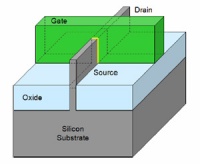3D transistor to be put into high-volume manufacturing
Chip maker Intel has announced a significant breakthrough in the evolution of the transistor, the microscopic building block of the microprocessor.

For the first time since the invention of silicon transistors more than 50 years ago, transistors using a three-dimensional structure will be put into high-volume manufacturing.
To do so, Intel will deploy a 3D transistor design called Tri-Gate into high-volume manufacturing in an Intel chip, codenamed ’Ivy Bridge’.
The three-dimensional transistors represent a fundamental departure from the two-dimensional planar transistor structures that have powered computers up until now.
The traditional ’flat’ two-dimensional planar gate has been replaced with a thin three-dimensional silicon fin that rises up vertically from the silicon substrate.
Control of the current through the transistor is accomplished by implementing a gate on each of the three sides of the fin — two on each side and one across the top — rather than just one on top, as is the case with a 2D planar transistor.

The additional control enables as much transistor current flowing as possible when the transistor is in the ’on’ state and as close to zero as possible when it is in the ’off’ state, and enables the transistor to switch quickly between the two states.
Register now to continue reading
Thanks for visiting The Engineer. You’ve now reached your monthly limit of news stories. Register for free to unlock unlimited access to all of our news coverage, as well as premium content including opinion, in-depth features and special reports.
Benefits of registering
-
In-depth insights and coverage of key emerging trends
-
Unrestricted access to special reports throughout the year
-
Daily technology news delivered straight to your inbox










Water Sector Talent Exodus Could Cripple The Sector
Maybe if things are essential for the running of a country and we want to pay a fair price we should be running these utilities on a not for profit...